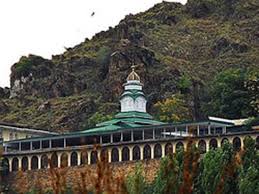Bashir Ahmad Dar
 Among the most venerated Sufis of Kashmir, Sheikh Hamza Makhdoom occupies the conspicuous position. Sheikh Hamza is regarded next to Sheikh Nuruddin Rishi, who is considered as the leader of the spiritual domain in Kashmir. If Sheikh Nuruddin is revered as Sheikh-ul-Alam, Shiekh Hamza is remembered as Mehboob-ul-Alam. Whereas the former is known as Alamdar-i-Kashmir, the latter is called as Sultan-ul-Arifeen. The locals as well as the foreigners have regarded these two Sufis as the leading spiritual leaders of Kashmir. It was most probably the reason that prompted the Afghan governor, Atta Muhammad Khan to mint the coins in the name of these two sons of soil.
Among the most venerated Sufis of Kashmir, Sheikh Hamza Makhdoom occupies the conspicuous position. Sheikh Hamza is regarded next to Sheikh Nuruddin Rishi, who is considered as the leader of the spiritual domain in Kashmir. If Sheikh Nuruddin is revered as Sheikh-ul-Alam, Shiekh Hamza is remembered as Mehboob-ul-Alam. Whereas the former is known as Alamdar-i-Kashmir, the latter is called as Sultan-ul-Arifeen. The locals as well as the foreigners have regarded these two Sufis as the leading spiritual leaders of Kashmir. It was most probably the reason that prompted the Afghan governor, Atta Muhammad Khan to mint the coins in the name of these two sons of soil.
After schooling and spiritual initiation he was destined to become the leading Sufi. The Sufi came to be known as Mehboobul Alam, Sutanul Arifeen Shaikh Hamza Makhdoom (R.A)
Born in 900 Hijra (1494 AD) at Tujar Sharief, formerly known as Zainagir and presently in Tehsil Sopore, he belonged to a pious family. His father was Baba Usman Raina and mother’s name was Bibi Maryam. Their pedigree is linked to Rajput dynasty and it is reported that it was Rawan Chandra, six generations preceding to Baba Usman, who was destined to embrace Islam during the reign of Rinchan Shah and came to be called as ‘Raina’. It may be added here that Rawan Chandra was the brother of famous Queen of Kashmir, Kota Rani, who had married Rinchana and later on assumed the reigns of the kingdom herself. Almost all the contemporaries and later on following them the chronicles and the chroniclers till date trace the genealogy of Rawan Chandra, like other Rajputs to the solar and lunar families (Suraj and Chandra Vanshi/Banshi). This predicament is not limited to the history of Kashmir but the same is attributed to the Rajput clans of India in the chronicles of India. But these and other myths do not have any basis in history. However the modern historians opine that the families who ruled in the country, in the course of time, began to be termed as rajputra or rajput that is the scion of the royal.
Sheikh Hamza Makhdoom was originally a follower of Kubrawi tradition. He, in his early childhood learnt at the feet of his father. Later on, on his migration to Srinagar, he was tutored by Sheikh Fathaullh, the son of Shaikh Isamil Kubrawi who had established Daru Shifa near Kohi Maraan. Akhund Mulla Lutufullah was also one of his teachers. Then he moved to the Khanqah of Shams Chak. He learnt the Quran, fiqh, Hadith, allied science, Suifstic traditions and was also conversant with some works of Mir Sayyid Ali Hamdani. He got initiation to the Suharwardi Silsilah at the hands of Sayyid Jallaud Din (1308-84) of Uchh, popularly known as Makhdum Jahaniyan-i-Jahan Gasht.
Right from his childhood, he was all through the virtuous and dedicated his life to the cause of Islam. He was instrumental in reforming hundreds and thousands of Muslims. He offered the nectar of Maurfat to all those who thronged his spiritual abode. It was at his hands that a number of his disciples were raised to the prominence in the Sufistic circles.
These include the illustrious Sufis Sheikh Daud Khaki, Mir Hyder Tulmuli, Khawaj Hasan Qari, Khawaja Ishaq Qari, Mulla Ahmad Chagli, Moulana Jami, Feroz Ganai, Mohammad Ali Raina, Baba Hardi Rishi, Mir Mohammad Afzal, Bayezid Shumnagi, Shaikh Roopa Rishi.
Sheikh Hamza Makhdoom (R.A) emphasized the importance of the continuous recitation of Zikhr so much so that he regarded it as a panacea for the troubles of heart. He says that from very beginning he had commenced reciting Harzi Yamani or Duai Saifi but as he came under the tutelage of his Murshid, he was instructed to discard all other recitations and to concentrate on Zikhri Allah as it possesses swift efficacy and tremendous significance. The tutor advised him that in case of any boredom he should recite Virdi Azam consisting of the verses of the Quran. Moreover Duai Moonisi Auliya was prescribed by the Murshid as a prayer after the Salah. Sheikh Hamza also recited Auradi Fateh and favoured its recitation by the commoners as initiated by Mir Sayyid Ali Hamdani (RA). He remarks that one who recites the Zikhr reaches the ultimate truth.
He toured every nook and corner of Kashmir and succeeded in establishing intimate contact with the people. He insisted on Sunnah being adhered to and the myths and legends to be discarded. The construction of mosques at a number of places particularly where the people dreaded ghosts and had ascribed myths may be regarded as a part of his campaign in furthering the cause of Islam. Hundreds of poor, destitute and hungry were fed in the hospice established by the saint at Kohi Maran. It was Sheikh Hamza (RA) who served as a meeting ground for the Rishis and Suharwardi saints. His influence extended to the Rishi movement as he enrolled some Rishis like Baba Hardi Rishi and Roopa Rishi as his disciple. By paying a visit to the tomb of Sheikh Nur ud Din Rishi (RA) he extended the influence of the Rishis even to the Suhawardi circles. It proved to be the reason that his disciples have preserved, with veneration, in their hagiographies the activities of the Rishis.
According to a contemporary account, Tazkirtul Murshideen by Miram Bazaz, a lesser known disciple of Sheikh Hamza, on his visit to Hardi Rishi (RA), Sheikh Hamza asked the former to taste food with him. Baba Hardi refused to taste the meat. He is said to have cited the exhortation of Khizr (AS), Christ (AS), Moses (AS), Idris (AS) and Illyas (AS) who are said to have been spiritually present on the occasion. Bab Hardi informed the host about the spiritual experience as the reason why he was hesitant to taste meat. Sheikh Hamza replied that it was the command of the Prophet Muhammad (S.A.W) that he should share non-vegetarian food with him. In order to dispel the Rishi’s doubt, Sheikh Hamza invoked the help of the Prophet Muhammad (S.A.W) whose spiritual presence finally caused the Rishi to share the non-vegetarian meal with Sheikh Hamza, though it was only once in his life to do so. Likewise Khawja Hassan Qari, the illustrious disciple of Sheikh narrates an anecdote of Sheikh Hamza thrashing a dervish with a stick who was indulging in Charus, to believe Qari leading to his ‘annihilation’. May be the account is riddled with supernatural events, however, the patent objective reality is that it signifies that Sheikh was very particular about following the Shariah.
It is said that Ghazi Chak who founded the Chak rule in Kashmir extern Sheikh Hamza from Srinagar. But these restrictions proved to be no impediment to his religious zeal. Settling in the village Wuhangam of Beeru Pargana, he continued his missionary activities. Khawaj Azim Didmari who has reported this event, adds a coincidence of the king turning ill and he deputed his princes to the saint pleading to reoccupy his seat of spiritual eminence at Srinagar. However, to believe Didmari, Sheikh Hamza declined the request of the deputation intimating them of his intention of not coming to Srinagar till the Sultan Ghazi Chak was alive. After the death of Gazi Shah Chak he returned to Srinagar.
It may be observed that none of the contemporaries have mentioned the event. Secondly believing the incident to be true, it is not clear what impelled the Sultan to extern the saint. Was it the fanatic attitude of the Sultan or his courtiers who had recently switched over to the Shia thought that led him to extern the saint from Srinagar? If the event is to be regarded as factual it indicates two implications. One that Sheikh Hamza had gained such a massive following that even a mighty ruler considered it as a threat to his reign. If so, it might have caused a wave of annoyance among the followers of the Sufi, persuading the ruler to invite him to the city. The incident may be viewed as a repetition of history as the rulers in general and tyrant and oppressive ones in particular have been at draggers drawn with the Ulmai and Sufai Haq.
The Sheikh breathed his last in 984 Hijra (1585 AD). Sultan Ali Shah Chak, the ruler of Kashmir is said to have attended his funeral prayer while it was led by Sheikh Tahir Rafiqi and it included contemporary scholars and Sufis like Sheikh Yaqub Sarfi. As per the instructions of the saint he was laid to rest at Kohi Maran, the centre of spiritual emancipation established by him. Nearly fifteen years after his departure, Akbar, the Mughal king, built a shrine there which was reconstructed during the Afghan rule by Atta Mohammad Khan around 1821 AD. As a mark of respect Atta Mohammad Khan stuck the coins bearing the names of Sheikh Nur-ud-Din-Rishi and Sheikh Hamza Makhdoom. This is probably the unique instance in the history when the coins have been stuck bearing the names of saints. This is also indicative of the reverence and the popularity the saints commanded among the people and also of the rulers.





